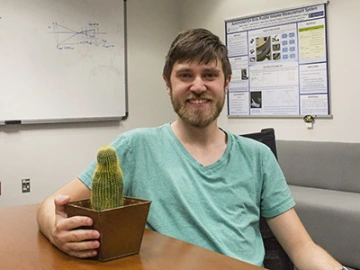Another Wavelength: Alex Erstad

We may be in the middle of Spring Break, but OSC's students are always hard at work. In the latest Another Wavelength, meet Alex Erstad, a Tucson native and junior in the optics track of the B.S. in OSE program.

What brought you to optics?
I did a summer program called the Research Mentorship Program at the University of California, Santa Barbara, between my junior and senior years of high school. I worked with wave guides, and that was what drew me to optics. Once I knew that's what I loved, it just happened to be perfect that the best school was right where I lived.
Who would you call your science hero?
My hero has to be Newton. Being one of the essential players in the founding of optics as a field, let alone all of the other contributions he has made, puts him at the top of my list.
Describe your research in 20 words or fewer.
I fabricate optical devices using a femtosecond laser system.
Describe your research in 200 words or fewer.
Working under professor Khanh Kieu, I use a femtosecond laser (a laser with pulses around 150 femtoseconds long) to modify materials in order to make optical devices. The effect that the laser has depends on how much power is used and can range from modifying the index of glass to cutting a fiber in half. One of my more recent projects involves creating a fiber Bragg grating by inducing a periodic index change along the core of a fiber. By doing this we can create a fiber laser at any wavelength that the fiber will allow.

Name three neat facts about you.
- I volunteer at the Humane Society of Southern Arizona, where I work socializing cats to help them come out of their shells so that potential adopters can see how good they really are.
- On a related note, my favorite buddy in the whole world is my cat, Freundlich, who I got from the Humane Society. (Her name is German for "friendly.")
- My current goal is either to work at a lab like MIT Lincoln Lab or go to graduate school and become a research professor.
